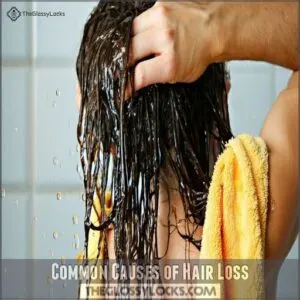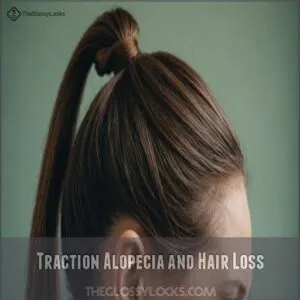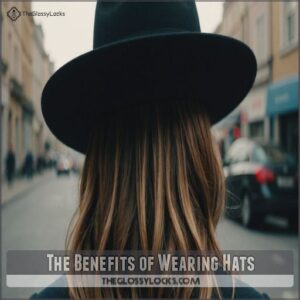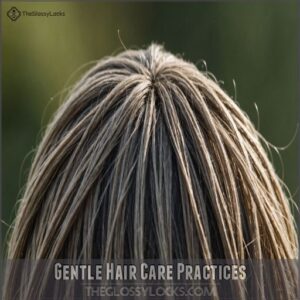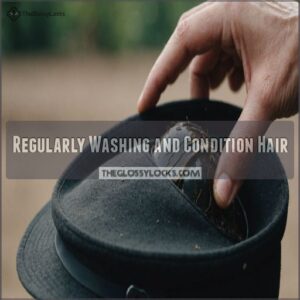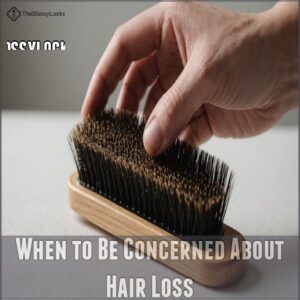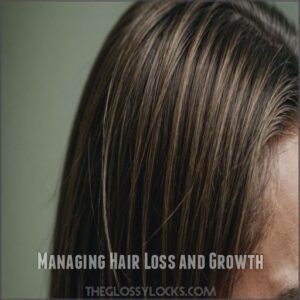This site is supported by our readers. We may earn a commission, at no cost to you, if you purchase through links.
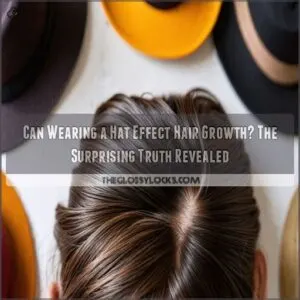 You’ll be relieved to know that wearing a hat doesn’t directly affect hair growth – your follicles aren’t fazed by what’s on your head.
You’ll be relieved to know that wearing a hat doesn’t directly affect hair growth – your follicles aren’t fazed by what’s on your head.
However, how you wear your hat matters.
Tight hats can cause traction alopecia, while sweaty, unwashed caps create a breeding ground for scalp issues.
Think of your hat like a roof: it should protect without suffocating.
You’re safe to rock your favorite baseball cap or beanie, but give your scalp some breathing room.
The real factors behind hair growth are more complex than headwear choices, and understanding them can help you maintain a healthy mane.
Table Of Contents
- Key Takeaways
- Separating Hat Myths From Facts
- Common Causes of Hair Loss
- How Hats Can Affect Hair Growth
- The Benefits of Wearing Hats
- Maintaining Healthy Hair Under Hats
- When to Be Concerned About Hair Loss
- Managing Hair Loss and Growth
- Frequently Asked Questions (FAQs)
- Can wearing a cap cause hair loss?
- What are the main causes of hair loss?
- Can smoking affect hair health?
- Can I prevent hair loss due to aging?
- How can I know the cause of my hair loss?
- Will wearing hats affect hair growth?
- What are the disadvantages of wearing a cap?
- Does keeping your head warm help hair grow?
- Is wearing a stocking cap bad for your hair?
- Do different hat materials affect hair health differently?
- Can switching between hats prevent potential damage?
- How long is too long wearing hats daily?
- Should people with thinning hair avoid certain hats?
- Do seasonal changes impact hat-wearing effects on hair?
- Conclusion
Key Takeaways
- Wearing a hat doesn’t directly affect hair growth, but tight hats can cause traction alopecia and scalp issues.
- Choose breathable hats, practice good hair hygiene, and give your scalp regular breaks to maintain healthy hair.
- Genetics, hormones, and overall health have a more significant impact on hair growth than hat-wearing habits.
- While hats can offer benefits like UV protection and temperature regulation, be mindful of potential risks like heat trapping and allergic reactions to materials.
Separating Hat Myths From Facts
You’ve probably heard conflicting claims about hats and hair loss, but what’s the real story?
Let’s examine the evidence and separate fact from fiction to understand how wearing hats might affect your hair growth.
Limited Scientific Evidence
Despite the buzz about hats and hair loss, there’s a surprising lack of solid scientific evidence.
Some research suggests that tight beanies can cause traction alopecia from tight beanies.
You’ve probably heard conflicting evidence abounds, we’re still waiting for thorough studies to separate fact from fiction.
Future research directions might finally unravel the mystery of how hats affect hair growth.
For now, the hat hair growth myth remains just that – a myth.
Potential Risks of Tight Hats
Tight hats can be a real pain for your hair.
While it’s not a one-size-fits-all problem, snug headwear might cause some issues.
Here’s what you need to watch out for:
- Reduced scalp circulation, potentially slowing hair growth
- Traction alopecia from constant pulling on hair follicles
- Increased sweat and oil buildup, leading to scalp irritation
- Pressure alopecia in extreme cases, causing temporary hair loss
Remember, moderation is key. Opt for looser fits to keep your head and hair happy.
Common Causes of Hair Loss
You’re not alone if you’ve noticed more hair in your brush lately; hair loss can stem from various factors beyond just wearing hats.
From genetics and hormonal changes, such as those that trigger alopecia barbae, a condition that causes patchy beard spots and can be treated with methods outlined in Alopecia Barbae Treatments, to medical conditions and medications, understanding the common causes of hair loss can help you address the issue effectively.
Genetics and Family History
While hats can impact hair, your genes often play a bigger role in hair loss.
You’ve inherited your hair traits from your family, which can influence hair loss patterns.
Let’s break down how genetics affect your locks:
| Genetic Factor | Impact on Hair | Common in |
|---|---|---|
| Androgen receptor gene | Increases hair loss risk | Male pattern baldness |
| X chromosome | Linked to female hair loss | Female pattern hair loss |
| Recessive genes | Can skip generations | Both genders |
Understanding your family history can help you take control of your hair’s future.
Hormonal Changes and Imbalances
Hormonal shifts can wreak havoc on your locks.
Your body’s chemical dance affects hair growth more than you might think.
From pregnancy’s glow to menopause’s challenges, hormones play a starring role in your hair’s story.
Here’s how hormonal changes can impact your mane:
- Pregnancy: Temporary thickening, followed by postpartum shedding
- Menopause: Thinning due to decreased estrogen
- Thyroid imbalances: Both over and underactive thyroids can cause hair loss
- Stress: Cortisol spikes may trigger temporary shedding
Understanding these hormonal influences can help you take control of your hair health.
Medical Conditions and Medications
Your body’s inner workings can sometimes throw your hair for a loop.
Certain medical conditions, like thyroid issues or autoimmune diseases, might lead to unexpected hair loss.
Some cancer patients also experience hair loss due to treatment, and may find helpful resources for managing this side effect at cancer hair loss products.
Medications, especially those for serious illnesses like cancer, can also cause your locks to thin out.
If you’re noticing more hair in your brush than usual, it’s worth chatting with your doctor. They can help pinpoint the cause and explore treatment options.
How Hats Can Affect Hair Growth
You’ve probably heard that wearing hats can cause hair loss, but is there any truth to this claim?
While hats don’t directly cause baldness, they can impact your hair’s health in subtle ways you mightn’t expect.
Traction Alopecia and Hair Loss
Constant tension on your locks can lead to traction alopecia.
Tight hairstyles and ill-fitting hats pull on your hair follicles, disrupting the growth cycle.
This can cause hair loss, especially along your hairline.
To protect your scalp health, opt for looser styles and well-fitted hats.
Give your hair a break by switching up your look regularly.
Remember, gentle care keeps your mane thriving and your style on point.
Heat and Sweat Trapping
Wearing a hat isn’t just about style—it can impact your scalp health too.
When you don a hat, especially in warm weather, you’re creating a mini sauna for your head.
This heat and sweat trapping can affect your hair follicles.
Here’s what you need to know:
- Excess moisture can lead to fungal growth
- Sweat buildup may clog hair follicles
- Heat can potentially damage hair proteins
- Poor ventilation might slow hair growth
To keep your locks luscious, opt for breathable hats and give your scalp some air time.
Allergic Reactions to Materials
Hats can sometimes be a headache, literally.
Some materials used in hats might trigger allergic reactions, leading to scalp irritation and potential hair loss.
It’s important to identify allergens and choose hat materials wisely.
For example, if you’ve experienced an allergic reaction after dyeing your hair, you might also be more prone to irritation from certain hat materials due to sensitive scalp reactions.
Here’s a quick guide to help you stay ahead of the game:
| Material | Potential Allergen | Prevention Tip |
|---|---|---|
| Wool | Lanolin | Choose hypoallergenic wool |
| Leather | Chromium | Opt for vegetable-tanned leather |
| Synthetic | Formaldehyde | Look for formaldehyde-free options |
By being mindful of these common culprits, you’ll keep your scalp happy and your hair healthy.
The Benefits of Wearing Hats
You’ll find that wearing hats offers more benefits than just adding style to your outfit, including protection from harmful UV rays and help with temperature control.
While many worry about hats causing hair loss, a properly fitted hat can actually protect your hair and scalp from sun damage and environmental stress.
UV Protection and Sun Damage Prevention
Your scalp needs reliable sun damage prevention just like your skin does.
By blocking harmful UV rays, a well-fitted hat acts as a natural UV filter, protecting your hair color and scalp health from sunburn.
Think of your hat as a shield that guards your hair’s strength and shine.
You’ll prevent long-term hair damage while keeping your locks looking vibrant and healthy.
Regulating Body Temperature
Smart body temperature regulation starts with a well-chosen hat.
During cold weather, you’ll keep up to 50% of body heat from escaping through your head, while in summer, the right hat helps manage sweating and prevents overheating.
Additionally, incorporating habits like regular scalp massage for relaxation can further support healthy blood flow to your scalp.
This balanced heat regulation supports healthy blood flow to your scalp, creating a great environment for hair follicle health and natural growth patterns.
Enhancing Outfits and Personal Style
Beyond keeping you cool, head accessories can transform your entire look.
A well-chosen hat becomes your signature style statement, boosting confidence while protecting your hair.
Here’s what wearing the right hat can do:
- Instantly elevates casual outfits to street-style worthy looks
- Creates a powerful first impression in professional settings
- Expresses personality without saying a word
- Covers bad hair days with effortless charm
Maintaining Healthy Hair Under Hats
You can keep your hair healthy while wearing hats by following a few simple care practices that protect your scalp and strands.
Breathable hat materials and good hair hygiene will help prevent common issues like excess oil buildup and friction damage.
Gentle Hair Care Practices
While hats offer great protection, maintaining healthy hair underneath requires a gentle touch.
Start with a relaxing scalp massage to boost circulation before putting on your hat.
When detangling, use a wide-toothed comb and work from tips to roots.
Regular hair washing and conditioning keep your scalp fresh, but don’t overdo it – twice a week is plenty for most people.
Choosing Breathable Hat Materials
Letting your scalp breathe makes all the difference in maintaining healthy hair growth.
Consider shopping for hats made from bamboo, like bamboo sun hats, which naturally allow for airflow and are a great option.
Natural fibers like cotton and bamboo offer excellent breathability, while synthetic moisture-wicking fabrics keep sweat at bay.
You’ll want to check the breathability rating on athletic hats and consider your climate when choosing materials.
Look for hats with built-in ventilation to keep your hair follicles happy and your scalp cool.
Regularly Washing and Condition Hair
The right fabric keeps your scalp happy, but proper cleaning makes all the difference.
You’ll want to maintain a consistent hair washing routine to prevent oil buildup under your hat.
A gentle sulfate-free shampoo removes dirt without stripping natural oils, while a lightweight conditioner keeps strands moisturized and manageable.
- Use pH-balanced shampoo to maintain scalp health
- Apply conditioner from mid-length to ends
- Let hair dry completely before wearing your hat
When to Be Concerned About Hair Loss
While it’s normal to lose up to 100 hairs a day, you’ll want to pay attention when you notice unusual hair shedding or thinning patches on your scalp.
If you’re finding more hair than usual on your pillow or seeing changes in your hairline that worry you, it’s time to check with your doctor.
Identifying Excessive Hair Shedding
Spotting excessive hair shedding starts with simple daily checks.
Count the strands in your hairbrush – finding 50-100 hairs is normal hair loss.
Keep an eye on your shower drain and pillowcase for unusual amounts.
You can also do a quick hairbrush test: run your fingers through dry hair over a light-colored surface and count what falls.
Beyond these numbers? It’s time to check with a doctor.
Noticing Thinning or Balding Patches
Monitoring your hairline can help you catch hair thinning early.
When you notice patches where your hair’s getting sparse, especially near your crown or temples, it’s worth paying attention.
Genetics and stress often team up to cause balding patterns, while medications and diet can play supporting roles – a well-balanced diet supplemented with hair growth vitamins.
To track changes, and remember early awareness puts you in control.
Consulting a Doctor for Advice
Red flags in your hair loss journey signal it’s time to consult a dermatologist for professional guidance.
You’ll want expert help to pinpoint underlying causes and explore treatment options suited to your needs.
Schedule an appointment when you notice significant changes in your hair’s thickness or pattern.
- Sudden loss of more than 100 hairs daily
- Alopecia areata, an autoimmune condition where the immune system attacks hair follicles, can cause anxiety linked hair loss. Patchy hair loss or circular bald spots
- Scalp irritation, redness, or scaling
- Family history of early baldness combined with accelerated hair loss
Managing Hair Loss and Growth
You can explore options like steroid injections or PRP therapy to stimulate hair growth, especially for conditions like alopecia areata. You’ll find relief knowing that managing hair loss and growth doesn’t require complex treatments or expensive solutions.
Whether you’re dealing with temporary shedding or long-term thinning, you can take control with proven strategies that address the root causes of your hair concerns.
Addressing Underlying Medical Conditions
Behind many hair loss cases lie medical conditions that need your attention.
Your thyroid’s health, hormonal balance, and immune system all play starring roles in your hair’s story.
When you’re dealing with unexplained hair loss, don’t just focus on your scalp – work with your doctor to uncover potential underlying conditions like autoimmune diseases or nutritional deficiencies that might be pulling your hair’s strings.
Using Medications and Supplements
Hair loss medications and supplements can be your trusted allies in the battle against thinning hair.
You’ll find both prescription options like finasteride and over-the-counter supplements containing biotin or saw palmetto.
When you’re considering treatment, you should talk to your doctor about potential side effects.
They’ll help you choose between topical solutions, oral medications, or natural supplements that best suit your needs.
Practicing Stress Reduction Techniques
Managing stress can work wonders for your hair follicles.
While medications play their part, you’ll find that mindfulness and meditation pack a powerful punch against hair loss.
Try incorporating yoga or deep breathing exercises into your daily routine – they’re like a gentle massage for your mind and scalp.
You’re not just helping your hair; you’re giving your whole body a chance to thrive.
Frequently Asked Questions (FAQs)
Can wearing a cap cause hair loss?
You won’t lose your hair from wearing a cap unless it’s extremely tight. While snug caps might temporarily reduce blood flow to follicles, regular cap-wearing doesn’t cause permanent hair loss.
What are the main causes of hair loss?
Several factors can trigger your hair loss, including genetics, hormonal changes, medical conditions, and stress.
Your family history often plays the biggest role, while medications and certain hairstyles may contribute too.
Can smoking affect hair health?
Believe it or not, those smoke rings aren’t just choking your lungs!
Studies reveal smoking constricts blood vessels, bombards hair follicles with toxins, and speeds up graying.
Your locks deserve better – they’re literally dying for you to quit.
Can I prevent hair loss due to aging?
Maintaining a healthy diet rich in vitamins and proteins can slow age-related hair loss.
You’ll benefit from gentle hair care, stress management, and consulting your doctor about treatments like minoxidil or finasteride.
How can I know the cause of my hair loss?
Like a detective solving a mystery, you’ll need to gather clues.
Check your family history, recent life changes, and medications.
Consult a doctor for a thorough examination.
They’ll help pinpoint the cause and chart your path forward.
Will wearing hats affect hair growth?
Wearing hats doesn’t directly affect hair growth.
While tight hats might temporarily reduce blood flow to follicles, there’s no solid evidence linking normal hat use to hair loss.
You’re safe to rock your favorite cap without worrying about your locks.
What are the disadvantages of wearing a cap?
Did you know 73% of people wear caps for sun protection?
While that’s smart, caps can cause scalp irritation, trap heat, and mess up your hairstyle.
They might also lead to temporary hair flattening or "hat hair.
Does keeping your head warm help hair grow?
Keeping your head warm doesn’t directly boost hair growth.
While good circulation helps, wearing protective styles like braids for hair growth can promote length retention by minimizing breakage and reducing manipulation, temperature alone won’t make your hair grow faster.
Focus on a healthy diet, gentle hair care, and addressing any underlying issues for better hair health.
Is wearing a stocking cap bad for your hair?
Imagine this: you’re cozy in your stocking cap, but is it harming your hair?
Generally, it’s not bad for your hair.
However, if it’s too tight or you wear it constantly, it could potentially cause some issues.
Opt for a loose fit.
Do different hat materials affect hair health differently?
Hat materials can indeed impact your hair’s health differently.
Breathable fabrics like cotton allow air circulation, reducing moisture buildup.
Synthetic materials might trap heat and sweat, potentially irritating your scalp.
Opt for natural, loose-fitting hats to keep your locks happy.
Can switching between hats prevent potential damage?
Ironically, you’d think switching hats would be a hair-saving dance, but it’s not that simple.
While alternating headwear might distribute pressure, it’s not a foolproof solution.
Focus on loose-fitting hats and good hair care instead.
How long is too long wearing hats daily?
There’s no strict time limit for daily hat-wearing, but it’s best to give your scalp some breathing room.
Try to take breaks throughout the day, and don’t sleep in your hat.
Listen to your scalp—if it’s irritated, ease up.
Should people with thinning hair avoid certain hats?
Imagine you’re at a hat store, eyeing a snug beanie.
If you’ve got thinning hair, you don’t need to avoid hats altogether.
Just opt for loose-fitting styles that won’t pull on your scalp or restrict blood flow.
Do seasonal changes impact hat-wearing effects on hair?
Seasonal changes can impact how hats affect your hair.
In summer, you might sweat more under a hat, potentially leading to scalp issues.
In winter, hats protect your hair from harsh weather but may cause static.
Adjust your hat-wearing habits accordingly.
Conclusion
Regarding hats and hair growth, you’re not out of the woods yet.
While wearing a hat doesn’t directly affect hair growth, how you wear it matters.
Tight hats can cause traction alopecia, and sweaty, unwashed caps may lead to scalp issues.
To keep your locks healthy, opt for breathable hats, practice good hair care, and give your scalp some air.
Remember, genetics and overall health play a bigger role in hair growth than your headwear choices.
So, can wearing a hat effect hair growth? Not directly, but smart hat habits help.


